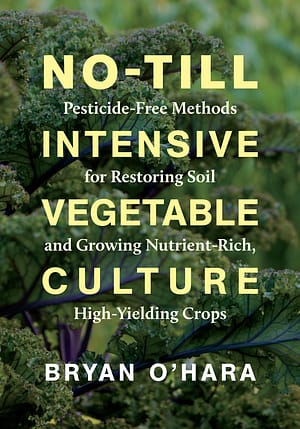Pros and Cons of Tillage

When it comes to tilling your soil, less equals more. “Why?” you may ask? Traditional tilling is exceptionally damaging to the soil in the long run. Occasional tillage may be necessary, such as before you start growing vegetables, or when you need to add supplements to depleted areas. In these cases, use a hand tool or a simpler tractor-till to save your soil.
The following is an excerpt from No-Till Intensive Vegetable Culture by Bryan O’Hara. It has been adapted for the web.
(All photography by Bryan O’Hara.)
Tillage, though inherently detrimental, can also provide some benefits to the vegetable grower. The natural state of agriculturally suitable land is a cover of perennial vegetation such as grasses, shrubs, and trees. Tillage is the traditional method to convert such land to vegetable production.
Most vegetables are fast-growing annuals, and annual plants are nature’s response to disturbance.

Our tractor-mounted tillage tools include a moldboard plow, a tined rod weeder, and a water-filled drum roller. We use these when converting new grow- ing areas to no-till.
Thus vegetables, to some degree, are a reasonable plant to cover a tilled soil. Tilling not only quickly converts land out of its natural perennial growth but also creates a surface that is appropriate for seeding or planting. Tillage destroys weeds and mixes fertilizers and organic materials into the soil profile and can break up plow pans and surface crusts.
Thus tillage may have beneficial results in terms of air and water movement, soil temperature, and residue decay. The need for many of these improvements, however, may actually arise from inappropriate past tillage events. To some degree tillage may lead to conditions where more tillage is needed, a sort of tillage treadmill effect.
For growers to best utilize tillage for potential benefits and avoid perpetuating the need for tillage, they must first identify a clear purpose for tilling and understand the damage that tillage events may cause. This provides the best chance that they will achieve their goal and inflict the least possible damage. Though nature is forgiving, over time repeated disturbance by tillage can wear down a soil’s ability to effectively recover.
The deterioration of soil structure leading to soil crusting and subsurface plow pans, increased erosion of soil, destruction of soil life, and the dramatic impact on the soil temperature and imbalance of soil air:water biology and nutrients are just the short list. The ramifications of these conditions on crop health can be extensive. Weeds respond to the disturbance with rampant growth. Damage and imbalance to the soil biology lead to nutrient imbalances that if unmanaged by growers quickly lead to disease and insect assault as well as poor growth with all manner of production difficulties, leading to lack of profitability. Fortunately, there is a better way.

A chisel plow can cut deep but produce minimal soil disturbance, even in a high-residue environment.
The transition from tillage systems to reduced tillage and finally to no-till is often gradual. As well, no-till may not be a permanent field condition, and some form of tillage may be reintroduced in order to achieve a specific goal such as eliminating an infestation of aggressive perennial weeds, with an eventual return to no-till when that goal is achieved.
Growers whose systems presently incorporate tillage may need to approach the conversion to reduced and no-tillage carefully, because it may take time to learn the intricacies of a new system. Experimentation with various methods on smaller areas as opposed to going cold turkey with tillage may well be more financially stable.
Likely there is no soil that would not benefit from an appropriate no-till system, as tillage is inherently unnatural and disruptive to soil biology and function.
No-till, in common agricultural terms, is often synonymous with herbicide usage, as the herbicide performs the primary function of elimination of existing vegetation.
Recommended Reads
Recent Articles
What’s so great about oyster mushrooms? First, you can add them to the list of foods that can be grown indoors! They are tasty, easy to grow, multiply fast, and they love a variety of substrates, making oyster mushrooms the premium choice. The following is an excerpt from Fresh Food from Small Spaces by R. J.…
Read MoreEver heard the phrase, “always follow your nose?” As it turns out, this is a good rule of thumb when it comes to chicken manure. Composting chicken manure in deep litter helps build better chicken health, reduce labor, and retain most of the nutrients for your garden. The following is an excerpt from The Small-Scale Poultry…
Read MoreIn her book, The Art of Science and Grazing, nationally known grazing consultant Sarah Flack identifies the key principles and practices necessary for farmers to design, and manage, successful grazing systems. This book is an essential guide for ruminant farmers who want to crate grazing systems that meet the needs of their livestock, pasture plants,…
Read MoreWant to start your own medicinal herb garden? Passionflower, lemon balm, and goldenseal are great places to begin! These herbs are jam-packed with medicinal properties and easy to grow in a majority of climates.
Read MoreThis long-lived perennial legume is used for forage and erosion control. Kudzu is edible with many medicinal uses and other applications. Pollinators of all kinds love its prodigious lavender blooms!
Read More








